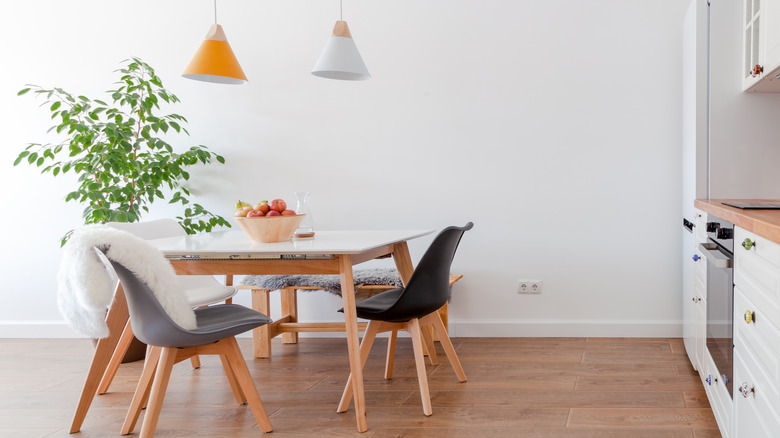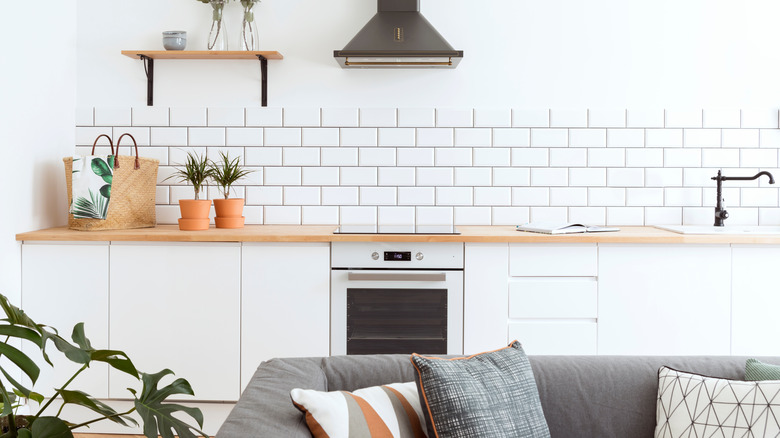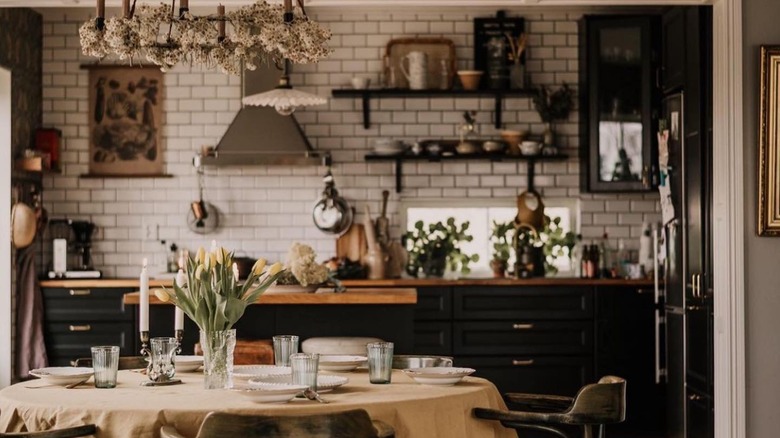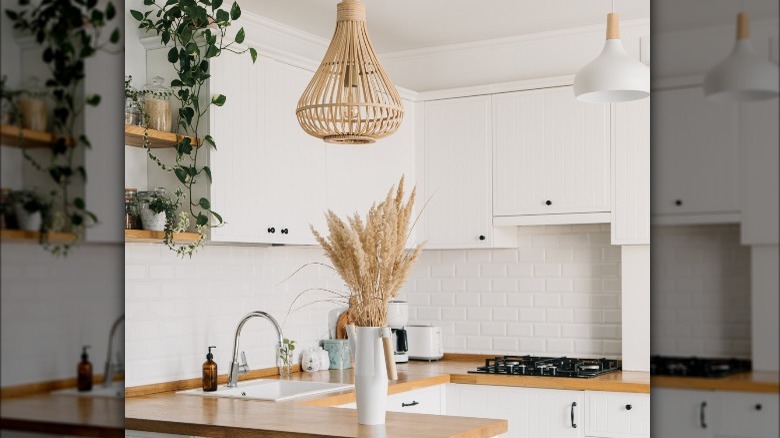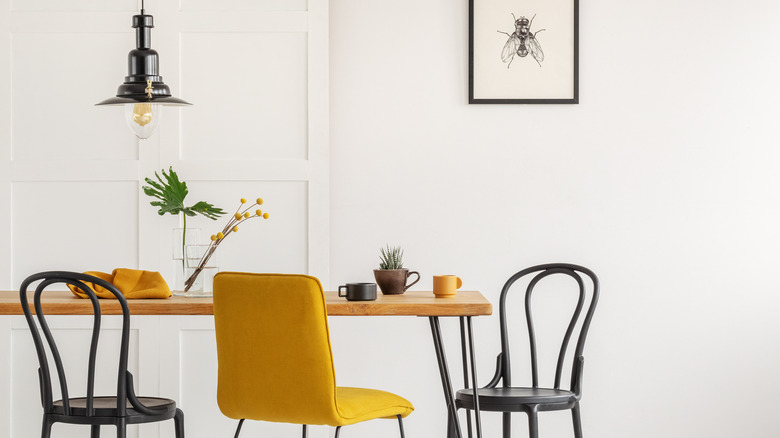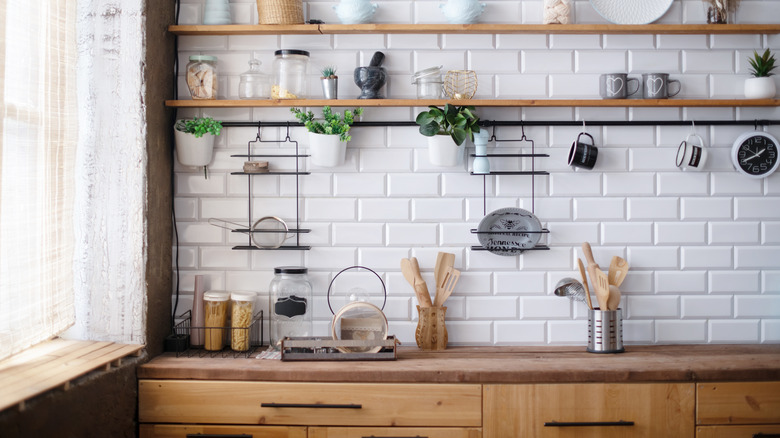5 Tips For Creating The Perfect Scandinavian-Style Kitchen
The Scandinavian-inspired design has peaked in popularity in recent years, but it seems to be here to stay for the foreseeable future. That's because its clean lines, tasteful use of color, and appeal to natural materials are sort of universally beloved. That's why the U.S. is the second biggest seller of Ikea wares, per Statista. When Ikea, the Swedish home design store, first opened its doors in 1985, people quickly fell in love with the affordable furniture that blended Scandinavian minimalism with modern design, and it's been a staple of home furniture ever since.
As some folks look to drop the heavy, bulky furniture of neo-traditionalism and others the starkness of ultra-modernism, Scandinavian décor is a happy, comfortable, and stylish medium. Our guide will walk you through five of the best tips for creating a Scandi-inspired kitchen area, from basic principles to items worth splurging on and essential cultural context.
1. Simplify your color palette
It's actually a misconception that Scandinavian design requires all-white everything compliance. First, keep in mind that Scandinavia, for the intents and purposes of this piece, is comprised of Denmark, Norway, and Sweden, though this definition can vary in different contexts. Project Nord notes that there is variation in preferred color palettes in specific Scandinavian countries, but there are a few principles to follow when styling for Scandi tastes.
White — and off-white — is a reliable choice as a primary color in your scheme. White-out kitchens are also totally acceptable. However, be sure not to conflate it with the popular all-white kitchens found in contemporary American homes, which typically have large islands and French-style layouts. But to add a little charm to the room, consider one to three accent colors as well. Muted, grey-tone, pastel colors, sage greens, and rusty terra cotta all fit well within the Scandinavian aesthetic.
2. Talk hygge to me
Hygge, coming from Danish and Norwegian homes, is another area of both Scandinavian lifestyle and design. Hygge is an adjective to describe toasty comfort or the sensation of cozy contentedness. There's no perfect English equivalent, but it can be roughly translated as a hug. Picture wool socks, a roaring fire, and hot cocoa stirred with a cinnamon stick. As Scandinavians face short days and long, cold winters, hygge is a way of embracing hunkering down and cozying up. In 2021, Denmark, Norway, and Sweden were among the world's top 10 happiest countries, per World Population Review, and while this can be attributed to many things, like living in generous welfare states, hygge is also a major contributor.
To bring hygge into your kitchen, there are a few things to focus on. For one, make sure you have plenty of light, but don't settle for icy fluorescents. Even if you can't alter your overhead lighting, you can add under-the-counter light strips, a table lamp, and plenty of unscented taper candles. In addition, try to keep fresh potted herbs on the countertop, as they recall the abundance of summer rolling all year long. Finally, curtains and table linens can also warm your kitchen and dining space.
3. Go unique on light features
While Scandinavian kitchens are meant to be clean and simple, you should still plan on adding some architectural details and high-end finishes. One of the best places to spend your budget is on light fixtures. As we mentioned earlier, warm, abundant lighting is essential to hygge living, so the light fixtures themselves can also totally transform your Scandi-inspired kitchen. As Scandinavia Standard notes, the emphasis is more on the type of light the fixture gives off, so you can have a lot of fun with the style itself. Pendants, table lamps, and floor lamps are all a part of Scandi design.
Keep in mind that the kitchen is not a place to skimp on lighting for safety reasons alone, so always make sure you have plenty of clear light in the space. Consider a woven rattan or matte brushed aluminum pendant light to go over your counter or island. On the counters under the cabinets, you can add a vintage table lamp to help you read cookbook pages and do prepping safely, all while giving the room an extra dose of warmth.
4. Make a kitchen fit for fika
Fika is the Swedish word for, well, coffee break, but it's more a lifestyle and state of mind than just a snack break, Scandikitchen notes. Though the Swedes have a cute word for it, this tradition is common throughout Scandinavia. Fika is not just snagging a pod for the Keurig and heading back to your desk. Instead, it's a significant break during the day, though separate from the standard lunch break. To fika, you need hot beverages, and usually a baked good of some kind. So you don't want your kitchen to be a purely functional space where you get in and out as quickly as possible.
To make a fika-ready kitchen, make sure you outfit the space with a kettle, mugs, saucers, and a comfortable chair to sit in. You can also create a coffee station on a rolling utility cart to display your mugs and other fikaware. Finally, add sheepskin covers (faux is fine!) to your dining chairs, or snag some cushions so you can savor every sip in your Scandi kitchen.
5. Don't knock natural
Natural finished lumber furniture pieces are an essential part of the Scandinavian design aesthetic. According to Gessato, the woods are typically beech, ash, and pine. Luckily, incorporating natural wood tones in the kitchen is extremely easy, with myriad options available to fit any budget. For example, butcher block countertops are a popular and stunning choice but can be costly and hard to maintain. The same goes for wood cabinets. Instead, try out olive wood utensils or even hardwood cutting boards to put on display.
Shelves are a relatively low-cost option if you want a more permanent wooden structure. You can use a freestanding bookshelf or easily DIY your own floating open shelves. Use our guide to shelving costs to get a better understanding of typical prices and how to use your budget. Additionally, you can hit up your local thrift store to find secondhand wood furniture at great prices; a lot of wood pieces just need a little sanding and staining to look like new.
